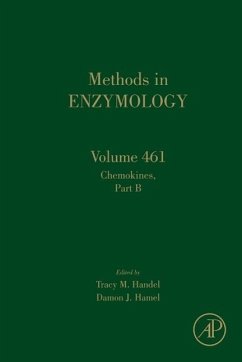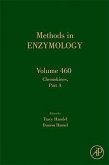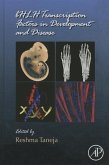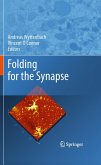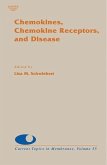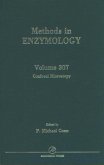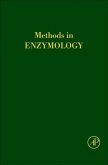Chemokines, Part B
Volume 461
Herausgegeben:Handel, Tracy; Hamel, Damon
Chemokines, Part B
Volume 461
Herausgegeben:Handel, Tracy; Hamel, Damon
- Gebundenes Buch
- Merkliste
- Auf die Merkliste
- Bewerten Bewerten
- Teilen
- Produkt teilen
- Produkterinnerung
- Produkterinnerung
The understanding of chemokines, the proteins that control the migration of cells, and their receptors, is critical to the study of causes and therapies for a wide range of human diseases and infections, including certain types of cancer, inflammatory diseases, HIV, and malaria. This volume, focusing on chemokine structure and function, as well as signaling, and its companion volume ( Methods in Enzymology volume 461, focusing on chemokines as potential targets for disease intervention) provide a comprehensive overview and time-tested protocols in this field, making it an essential reference for researchers in the area.…mehr
Andere Kunden interessierten sich auch für
![Chemokines, Part a Chemokines, Part a]() Chemokines, Part a127,99 €
Chemokines, Part a127,99 €![DNA Repair Enzymes: Cell, Molecular, and Chemical Biology DNA Repair Enzymes: Cell, Molecular, and Chemical Biology]() DNA Repair Enzymes: Cell, Molecular, and Chemical Biology117,99 €
DNA Repair Enzymes: Cell, Molecular, and Chemical Biology117,99 €![Bhlh Transcription Factors in Development and Disease Bhlh Transcription Factors in Development and Disease]() Bhlh Transcription Factors in Development and Disease116,99 €
Bhlh Transcription Factors in Development and Disease116,99 €![Folding for the Synapse Folding for the Synapse]() Folding for the Synapse149,99 €
Folding for the Synapse149,99 €![Chemokines, Chemokine Receptors and Disease Chemokines, Chemokine Receptors and Disease]() Lisa M. Schwiebert (Volume ed.)Chemokines, Chemokine Receptors and Disease131,99 €
Lisa M. Schwiebert (Volume ed.)Chemokines, Chemokine Receptors and Disease131,99 €![Confocal Microscopy Confocal Microscopy]() John N. Abelson / Melvin I. Simon / P. Michael Conn (Volume ed.)Confocal Microscopy125,99 €
John N. Abelson / Melvin I. Simon / P. Michael Conn (Volume ed.)Confocal Microscopy125,99 €![Biothermodynamics, Part D Biothermodynamics, Part D]() Biothermodynamics, Part D124,99 €
Biothermodynamics, Part D124,99 €-
-
-
The understanding of chemokines, the proteins that control the migration of cells, and their receptors, is critical to the study of causes and therapies for a wide range of human diseases and infections, including certain types of cancer, inflammatory diseases, HIV, and malaria. This volume, focusing on chemokine structure and function, as well as signaling, and its companion volume (Methods in Enzymology volume 461, focusing on chemokines as potential targets for disease intervention) provide a comprehensive overview and time-tested protocols in this field, making it an essential reference for researchers in the area.
Produktdetails
- Produktdetails
- Methods in Enzymology Volume 461
- Verlag: Academic Press / Elsevier Science & Technology
- Artikelnr. des Verlages: S0076-6879(09)X0028-5
- Seitenzahl: 350
- Erscheinungstermin: 12. Juni 2009
- Englisch
- Abmessung: 229mm x 155mm x 33mm
- Gewicht: 920g
- ISBN-13: 9780123749079
- ISBN-10: 0123749077
- Artikelnr.: 26173787
- Herstellerkennzeichnung
- Libri GmbH
- Europaallee 1
- 36244 Bad Hersfeld
- 06621 890
- Methods in Enzymology Volume 461
- Verlag: Academic Press / Elsevier Science & Technology
- Artikelnr. des Verlages: S0076-6879(09)X0028-5
- Seitenzahl: 350
- Erscheinungstermin: 12. Juni 2009
- Englisch
- Abmessung: 229mm x 155mm x 33mm
- Gewicht: 920g
- ISBN-13: 9780123749079
- ISBN-10: 0123749077
- Artikelnr.: 26173787
- Herstellerkennzeichnung
- Libri GmbH
- Europaallee 1
- 36244 Bad Hersfeld
- 06621 890
Professor, Skaggs School of Pharmacy and Pharmaceutical Sciences and Department of Pharmacology, School of Medicine, University of California, USA
STRUCTURE AND FUNCTION
1. A Novel Chemokine-mediated In Vivo T Cell Recruitment Assay for Structure Function Studies
(Andrew D. Luster and Gabriele Campanella)
2. Tyrosine sulfation of HIV-1 coreceptors and other chemokine-binding receptors (Micheal R. Farzan)
3. Lymphotactin Structural Dynamics (Brian F. Volkman)
4. Regulation of chemokines by posttranslational modifications (Paul Proost )
5. Proteolytic Processing of Chemokines: Mass Spectrometry, Biochemistry, Neoepitope Antibody and Functional Characterization (Christopher Overall and Amanda Starr)
6. Multiple approaches to study Chemokine Receptor Homo and Heterodimerization (Mario Mellado)
7. Heterodimerization of Chemokine Receptors with Other GPCRs (Graeme Milligan and Shirley Appelbe)
8. Homo and Hetero-Oligomerization of Chemokines (Tracy Handel, Damon Hamel, Ariane Jansma)
9. Interactions of Chemokine with Glycosaminoglycans (Amanda Proudfoot)
10. Interactions of Chemokine with Glycosaminoglycans (Andreas J. Kungl)
11. Structures of Chemokine:Chemokine Binding Protein Complexes (Daved Fremont)
12. Activation Mechanisms of Chemokine Receptors (Mette Rosenkilde)
13. Modeling Small Molecule Compound Binding to Receptors (Richard Horuk, James Pease, N. Vaidehi)
14. Spectroscopic Approaches to Study Conformational Changes in GPCRs (David Farrens)
15. Plasmon Resonance Methods in GPCR Signaling (Victor Hruby, Isabel Alves, Gordon Tollin)
16. Flow Cytometric Analyses of GPCR Interactions or Rapid-mix flow cytometry measurements of subsecond regulation of G protein-coupled receptor ternary complex dynamics (Larry Sklar)
17. Expression and Functional Reconstitution of CCR1 (Tracy Handel and Samantha Allen, Damon Hamel)
18. Characterization of the Interactions of Chemokines with Glycosaminoglycans by Fourier Transform Ion Cyclotron Resonance (Julie A. Leary)
CHEMOKINE FUNCTION IN CELL MIGRATION
19. In vitro assays for studying chemokine-triggered lymphocyte transendothelial migration under physiological flow conditions (Ronen Alon and Francis Lin)
20. Microfluidic device (Eugene Butcher)
21. Two-photon imaging and quantitative analysis of leukocyte migration in vivo (Mark Miller and Jenna Cash)
22. Zymosan induced peritonitis as a model for studying chemokines and inflammatory mediators in vivo (David Greaves)
1. A Novel Chemokine-mediated In Vivo T Cell Recruitment Assay for Structure Function Studies
(Andrew D. Luster and Gabriele Campanella)
2. Tyrosine sulfation of HIV-1 coreceptors and other chemokine-binding receptors (Micheal R. Farzan)
3. Lymphotactin Structural Dynamics (Brian F. Volkman)
4. Regulation of chemokines by posttranslational modifications (Paul Proost )
5. Proteolytic Processing of Chemokines: Mass Spectrometry, Biochemistry, Neoepitope Antibody and Functional Characterization (Christopher Overall and Amanda Starr)
6. Multiple approaches to study Chemokine Receptor Homo and Heterodimerization (Mario Mellado)
7. Heterodimerization of Chemokine Receptors with Other GPCRs (Graeme Milligan and Shirley Appelbe)
8. Homo and Hetero-Oligomerization of Chemokines (Tracy Handel, Damon Hamel, Ariane Jansma)
9. Interactions of Chemokine with Glycosaminoglycans (Amanda Proudfoot)
10. Interactions of Chemokine with Glycosaminoglycans (Andreas J. Kungl)
11. Structures of Chemokine:Chemokine Binding Protein Complexes (Daved Fremont)
12. Activation Mechanisms of Chemokine Receptors (Mette Rosenkilde)
13. Modeling Small Molecule Compound Binding to Receptors (Richard Horuk, James Pease, N. Vaidehi)
14. Spectroscopic Approaches to Study Conformational Changes in GPCRs (David Farrens)
15. Plasmon Resonance Methods in GPCR Signaling (Victor Hruby, Isabel Alves, Gordon Tollin)
16. Flow Cytometric Analyses of GPCR Interactions or Rapid-mix flow cytometry measurements of subsecond regulation of G protein-coupled receptor ternary complex dynamics (Larry Sklar)
17. Expression and Functional Reconstitution of CCR1 (Tracy Handel and Samantha Allen, Damon Hamel)
18. Characterization of the Interactions of Chemokines with Glycosaminoglycans by Fourier Transform Ion Cyclotron Resonance (Julie A. Leary)
CHEMOKINE FUNCTION IN CELL MIGRATION
19. In vitro assays for studying chemokine-triggered lymphocyte transendothelial migration under physiological flow conditions (Ronen Alon and Francis Lin)
20. Microfluidic device (Eugene Butcher)
21. Two-photon imaging and quantitative analysis of leukocyte migration in vivo (Mark Miller and Jenna Cash)
22. Zymosan induced peritonitis as a model for studying chemokines and inflammatory mediators in vivo (David Greaves)
STRUCTURE AND FUNCTION
1. A Novel Chemokine-mediated In Vivo T Cell Recruitment Assay for Structure Function Studies
(Andrew D. Luster and Gabriele Campanella)
2. Tyrosine sulfation of HIV-1 coreceptors and other chemokine-binding receptors (Micheal R. Farzan)
3. Lymphotactin Structural Dynamics (Brian F. Volkman)
4. Regulation of chemokines by posttranslational modifications (Paul Proost )
5. Proteolytic Processing of Chemokines: Mass Spectrometry, Biochemistry, Neoepitope Antibody and Functional Characterization (Christopher Overall and Amanda Starr)
6. Multiple approaches to study Chemokine Receptor Homo and Heterodimerization (Mario Mellado)
7. Heterodimerization of Chemokine Receptors with Other GPCRs (Graeme Milligan and Shirley Appelbe)
8. Homo and Hetero-Oligomerization of Chemokines (Tracy Handel, Damon Hamel, Ariane Jansma)
9. Interactions of Chemokine with Glycosaminoglycans (Amanda Proudfoot)
10. Interactions of Chemokine with Glycosaminoglycans (Andreas J. Kungl)
11. Structures of Chemokine:Chemokine Binding Protein Complexes (Daved Fremont)
12. Activation Mechanisms of Chemokine Receptors (Mette Rosenkilde)
13. Modeling Small Molecule Compound Binding to Receptors (Richard Horuk, James Pease, N. Vaidehi)
14. Spectroscopic Approaches to Study Conformational Changes in GPCRs (David Farrens)
15. Plasmon Resonance Methods in GPCR Signaling (Victor Hruby, Isabel Alves, Gordon Tollin)
16. Flow Cytometric Analyses of GPCR Interactions or Rapid-mix flow cytometry measurements of subsecond regulation of G protein-coupled receptor ternary complex dynamics (Larry Sklar)
17. Expression and Functional Reconstitution of CCR1 (Tracy Handel and Samantha Allen, Damon Hamel)
18. Characterization of the Interactions of Chemokines with Glycosaminoglycans by Fourier Transform Ion Cyclotron Resonance (Julie A. Leary)
CHEMOKINE FUNCTION IN CELL MIGRATION
19. In vitro assays for studying chemokine-triggered lymphocyte transendothelial migration under physiological flow conditions (Ronen Alon and Francis Lin)
20. Microfluidic device (Eugene Butcher)
21. Two-photon imaging and quantitative analysis of leukocyte migration in vivo (Mark Miller and Jenna Cash)
22. Zymosan induced peritonitis as a model for studying chemokines and inflammatory mediators in vivo (David Greaves)
1. A Novel Chemokine-mediated In Vivo T Cell Recruitment Assay for Structure Function Studies
(Andrew D. Luster and Gabriele Campanella)
2. Tyrosine sulfation of HIV-1 coreceptors and other chemokine-binding receptors (Micheal R. Farzan)
3. Lymphotactin Structural Dynamics (Brian F. Volkman)
4. Regulation of chemokines by posttranslational modifications (Paul Proost )
5. Proteolytic Processing of Chemokines: Mass Spectrometry, Biochemistry, Neoepitope Antibody and Functional Characterization (Christopher Overall and Amanda Starr)
6. Multiple approaches to study Chemokine Receptor Homo and Heterodimerization (Mario Mellado)
7. Heterodimerization of Chemokine Receptors with Other GPCRs (Graeme Milligan and Shirley Appelbe)
8. Homo and Hetero-Oligomerization of Chemokines (Tracy Handel, Damon Hamel, Ariane Jansma)
9. Interactions of Chemokine with Glycosaminoglycans (Amanda Proudfoot)
10. Interactions of Chemokine with Glycosaminoglycans (Andreas J. Kungl)
11. Structures of Chemokine:Chemokine Binding Protein Complexes (Daved Fremont)
12. Activation Mechanisms of Chemokine Receptors (Mette Rosenkilde)
13. Modeling Small Molecule Compound Binding to Receptors (Richard Horuk, James Pease, N. Vaidehi)
14. Spectroscopic Approaches to Study Conformational Changes in GPCRs (David Farrens)
15. Plasmon Resonance Methods in GPCR Signaling (Victor Hruby, Isabel Alves, Gordon Tollin)
16. Flow Cytometric Analyses of GPCR Interactions or Rapid-mix flow cytometry measurements of subsecond regulation of G protein-coupled receptor ternary complex dynamics (Larry Sklar)
17. Expression and Functional Reconstitution of CCR1 (Tracy Handel and Samantha Allen, Damon Hamel)
18. Characterization of the Interactions of Chemokines with Glycosaminoglycans by Fourier Transform Ion Cyclotron Resonance (Julie A. Leary)
CHEMOKINE FUNCTION IN CELL MIGRATION
19. In vitro assays for studying chemokine-triggered lymphocyte transendothelial migration under physiological flow conditions (Ronen Alon and Francis Lin)
20. Microfluidic device (Eugene Butcher)
21. Two-photon imaging and quantitative analysis of leukocyte migration in vivo (Mark Miller and Jenna Cash)
22. Zymosan induced peritonitis as a model for studying chemokines and inflammatory mediators in vivo (David Greaves)

